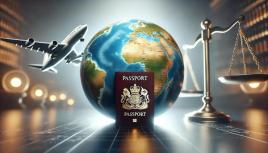
Blogs • January 6, 2026 • 14 Min
Where Can You Live Tax-Free in 2026?
In a world where tax rules change faster than residency laws, more individuals and international entrepreneurs are asking a simple question: where can you legally live, invest, and structure your life with minimal or zero taxation? Tax-free countries, often referred to as zero-tax jurisdictions, remain highly relevant in 2026, but the reality is more nuanced than headlines suggest. While some countries genuinely impose no personal income tax, others combine selective tax exemptions with strict residency rules, compliance requirements, and lifestyle trade-offs. In this guide, we will explain what “tax-free” really means today, how these jurisdictions work in practice, and how to evaluate whether a zero-tax country fits your personal or business goals. What Is a Tax-Free Country in 2026? A tax-free country is a jurisdiction that does not levy certain major taxes on individuals or businesses. In most cases, this refers to the absence of personal income tax, but it can also extend to corporate tax, capital gains tax, or inheritance tax. Importantly, tax-free does not mean cost-free or regulation-free. These countries fund public services through alternative revenue models such as: Natural resource income (oil, gas) Tourism and consumption taxes Real estate and residency fees Government-controlled investment funds Tax-free systems are typically transparent, regulated, and internationally compliant, especially in jurisdictions that host large expatriate and investor populations. Which Taxes Are Usually Not Charged in Tax-Free Countries? Most tax-free jurisdictions remove one or more of the following taxes. Personal income tax: No tax on salaries, professional income, or self-employment earnings. Capital gains tax: Profits from selling shares, crypto, businesses, or property are not taxed locally. Dividend and interest tax: Investment income is often received gross. Inheritance or wealth tax: Assets can typically be transferred without local estate taxation. That said, indirect taxes such as VAT, customs duties, municipality fees, or social contributions may still apply depending on the country and your activity. Are Tax-Free Countries the Same as Tax Havens? No. While they are often confused, tax-free countries and tax havens are not the same. Tax-free countries openly design their systems to attract residents, professionals, and businesses through clear legislation. Their tax benefits are publicly available and usually tied to residency or economic presence. Tax havens, on the other hand, are typically used for structuring and asset holding, rather than relocation. They may offer: Very low or zero taxes Specialized legal vehicles Limited physical residency requirements Many traditional “tax haven” models are under tighter global scrutiny, while tax-free residency jurisdictions remain fully viable when structured correctly. Which Jurisdictions Are Commonly Classified as Tax Havens? Examples often cited as tax havens include: Switzerland Luxembourg Singapore Hong Kong Ireland Isle of Man Panama British Virgin Islands Liechtenstein These jurisdictions are primarily used for corporate structuring, fund vehicles, and international finance, rather than lifestyle relocation alone. Why Does This Distinction Matter for You? Because where you live and where you structure assets are not always the same. Successful tax planning often combines residency in a tax-free or low-tax country, and compliant international structuring, aligned with reporting rules and substance requirements. This is where strategic planning matters far more than chasing “zero tax” headlines. Authority Note At Savory & Partners, we work with internationally mobile individuals, entrepreneurs, and families to design legal, compliant residency and tax strategies based on where you live, how you earn, and where your assets are located. Which Are the Best Tax-Free Countries to Live In in 2026? Not all zero-tax countries are practical for long-term residence. In 2026, the most relevant tax-free jurisdictions are those that combine legal residency pathways, international compliance, and real-life livability, not just zero tax on paper. Below are the countries that continue to attract investors, entrepreneurs, and globally mobile professionals. Why the United Arab Emirates Remains the Benchmark The UAE offers one of the most functional tax-free lifestyles globally. There is no personal income tax, no tax on dividends or capital gains for individuals, and strong infrastructure built specifically for expatriates. While a federal corporate tax exists, it applies selectively and does not affect most private individuals. Key reasons the UAE works in 2026: Residency is accessible through employment, business, or real estate Banking and payments are globally integrated Lifestyle, safety, and connectivity are high-level For many clients, the UAE is the starting point of a broader international structure. Is Monaco Still Tax-Free in Practice? Yes, for individuals, Monaco remains one of the few European zero-income-tax jurisdictions. Residents do not pay personal income tax, capital gains tax, or wealth tax. However, access is tightly controlled and living costs are among the highest in the world. Monaco works best if: You already have substantial capital You do not rely on employment income You can demonstrate strong financial self-sufficiency It is a lifestyle-driven choice, not a mass relocation option. What Makes the Bahamas Attractive for Tax Residency? The Bahamas offers full tax neutrality for residents. There is no income tax, capital gains tax, or inheritance tax. Residency can be obtained through real estate investment or annual permits, making it flexible for those who do not need local employment. The Bahamas suits you if: Your income is generated abroad You prefer a low-regulation environment You value simplicity over scale Is Bermuda Still Relevant in 2026? Yes, but it is niche. Bermuda remains tax-free for individuals, with no income or capital gains tax. However, residency access is limited and property thresholds are high. Bermuda is best aligned with: Insurance and reinsurance professionals Individuals with existing corporate links High-budget relocation plans Why the Cayman Islands Are Popular with Investors The Cayman Islands offer one of the cleanest zero-tax systems globally. There are no direct taxes at all. Residency is primarily investment-based, and compliance standards are strict but clear. Cayman works well if: You hold investment income or business profits abroad You want long-term tax certainty You are comfortable with a high-cost environment Does Brunei Still Offer a Tax-Free Lifestyle? Yes, but access is limited. Brunei has no personal income tax, funded largely by hydrocarbons. However, residency is typically linked to employment, not investment. This is a viable option only if: You have a direct employment pathway Your industry aligns with local demand Lifestyle and cultural factors fit your expectations Tax-Free Countries at a Glance Important Tax-free does not automatically mean tax-resident-free elsewhere. Your previous country of residence, citizenship, and source of income still matter. This is why relocation planning must consider: Exit tax exposure Substance rules Reporting obligations Long-term residency stability At Savory & Partners, this is exactly where we focus. The goal is to help you choose the right jurisdiction for how you live and earn. What Do You Actually Need to Live in a Tax-Free Country? Does Residency Automatically Make You Tax-Free? No. Residency and tax residency are not the same thing. Most tax-free countries require you to actively establish tax residency before local tax exemptions apply. This usually involves a combination of legal residence status, physical presence, and economic substance. You may legally hold a residence permit but still remain tax resident elsewhere if: You do not meet minimum stay thresholds Your personal or economic ties remain abroad Your previous country applies exit or tie-breaker rules This distinction is one of the most common mistakes in relocation planning. What Are the Typical Residency Requirements in Tax-Free Countries? Each jurisdiction applies its own residency logic. Below is a practical overview of how this works in 2026. United Arab Emirates Residency via employment, business ownership, or real estate No formal minimum stay for residency validity Tax residency certificate generally requires physical presence and local ties This flexibility is one reason the UAE remains central to global mobility planning. Monaco Proof of accommodation and financial self-sufficiency required Local presence expected throughout the year Strong scrutiny of lifestyle and center of life Monaco is strict but consistent. Bahamas Permanent residency via qualifying real estate Annual residency permits available without work rights Physical presence expectations are moderate Often used by individuals with externally sourced income. Cayman Islands Investment-based permanent residency Income thresholds apply Long-term presence expected to maintain status Designed for financially independent residents. How Important Is Physical Presence in 2026? More important than before. While tax-free countries are not bound by the traditional 183-day rule, international enforcement has tightened. Authorities increasingly assess where you sleep most nights, where your family lives, where your business is managed from and where you hold bank accounts and assets. In practice, substance matters more than formal labels. Can You Run a Business from a Tax-Free Country? Is Business Ownership Still Tax-Efficient in Zero-Tax Jurisdictions? Yes, but only when structured correctly. Tax-free countries remain highly attractive for entrepreneurs, but 2026 structures must align with: Economic substance rules Corporate tax thresholds International reporting standards Below is how this works in reality. How Business Setup Works in Key Tax-Free Jurisdictions United Arab Emirates The UAE remains the most flexible option. You can choose between: Free zone companies with full foreign ownership Mainland companies for local market access Corporate tax applies only above specific thresholds and does not affect personal income. For many founders, the UAE functions as both residency base and operational hub. Cayman Islands Cayman companies are widely used for: Investment funds Holding structures International financing They are not designed for operational businesses with staff on the ground, but for capital and asset-based activities. Bahamas International Business Companies remain tax-neutral and are often used for: Asset holding International trade IP ownership Local operations are limited unless additional licenses are obtained. What Should You Expect from Banking and Compliance? Is Banking Easy in Tax-Free Countries? It is structured, not easy. In 2026, all reputable tax-free jurisdictions enforce strict AML checks, source-of-funds verification and ongoing account monitoring. This is not a disadvantage. It is what keeps these jurisdictions internationally accepted. What Banks Typically Require You should expect to provide: Proof of residency Clear source of income Business activity explanation Tax compliance declarations from previous jurisdictions Jurisdictions like the UAE, Cayman Islands, and Monaco offer high-quality banking, but preparation is critical. How Expensive Is Life in a Tax-Free Country? Is Living in a Tax-Free Country Always Expensive? Not necessarily, but you should expect trade-offs. In 2026, many tax-free countries offset low or zero income taxes with higher everyday costs. This does not automatically make them bad choices, but it does mean you need to look beyond tax rates and think about your actual lifestyle. In practice, higher costs usually come from structural realities rather than policy choices. Limited land, heavy reliance on imports, and strong demand from expatriates all push prices up in places like Monaco or the Cayman Islands. On the other hand, countries such as the UAE or the Bahamas offer more flexibility, especially if you tailor where and how you live. What matters most is not whether a country is “expensive,” but whether the tax savings meaningfully outweigh the cost of living for you. A useful way to think about it is this: Would you rather pay higher rent and no income tax, or moderate rent and ongoing taxation? The answer is personal, and it depends entirely on how and where you earn. Is a Tax-Free Country Better Than a Low-Tax Country? The real difference is not tax levels, but how much flexibility you gain or lose. Tax-free countries remove entire categories of taxation. Low-tax countries, by contrast, still tax you, but often in a more predictable and lifestyle-friendly way. Today, many globally mobile individuals intentionally choose low-tax jurisdictions because they value long-term stability, EU access, or family considerations more than absolute tax elimination. If you step back, the decision usually comes down to how you want to live day to day. Tax-free countries tend to work best when: Your income is generated internationally You do not rely on local employment You value simplicity and predictability You are comfortable with higher entry thresholds Low-tax countries often make more sense when: You want deeper integration into a local system You plan to settle long term You value healthcare, education, and citizenship pathways You prefer moderate taxes over structural limitations How Do These Two Options Compare in Real Life? This is why there is no universal “better” option. The right choice depends on how your income, mobility, and personal plans intersect. Why Some People Choose Low-Tax Europe Instead Why Do Countries Like Portugal and Malta Still Attract Globally Mobile Individuals? Because they offer balance, not extremes. Portugal and Malta remain relevant in 2026 not because they are tax-free, but because they combine manageable taxation with strong residency rights, lifestyle quality, and legal clarity. Portugal appeals to people who want: A clear path to permanent residency and citizenship A stable EU base A moderate cost of living relative to Western Europe Malta attracts those who value: English-language legal and business systems Remittance-based taxation structures EU access with relatively compact geography In both cases, you accept some level of taxation, but you gain long-term security and integration. For many families and entrepreneurs, that trade-off feels reasonable. Who Should Actually Choose a Tax-Free Country in 2026? When Does a Zero-Tax Jurisdiction Make Sense for You? A tax-free country makes sense when your income is mobile and your lifestyle is flexible. If you earn internationally, manage investments or businesses remotely, and do not need deep integration into a local labor market, tax-free jurisdictions can be extremely effective. They simplify your tax exposure and reduce long-term planning friction. They are less suitable if you: Depend on local employment Need broad EU mobility Prefer gradual settlement paths Are sensitive to high upfront relocation or property costs The mistake many people make is treating tax-free countries as universal solutions. In reality, they are precision tools, not default answers. A 2026 Perspective Worth Keeping in Mind The lowest-tax country is rarely the smartest choice on its own. What matters is how well a country aligns with: Where you actually live Where your income is generated Where your family and assets are based How stable the rules are over time At Savory & Partners, this is why tax planning is always approached through the lens of residency, substance, and long-term viability, not rankings or headlines. What Investment or Financial Commitment Is Required in Tax-Free Countries? Do You Need to Invest to Live in a Tax-Free Country? In most cases, yes, either directly or indirectly. In 2026, tax-free countries rarely grant long-term residency without some form of economic contribution. This does not always mean a formal “investment program,” but it does mean you must demonstrate financial independence, local ties, or economic value. For you, this usually takes one of three forms: Real estate ownership Business setup or ownership Stable income combined with local residency The exact structure matters less than whether it is credible, sustainable, and compliant. What Are the Typical Investment Thresholds in 2026? Below is a practical, simplified overview of common entry points. Actual requirements vary based on family size, visa type, and structuring. Important: These figures are entry points, not guarantees. How you structure matters just as much as how much you invest. What Are the Most Common Mistakes People Make? Why Do Tax-Free Relocations Often Fail? Most failures are not tax-related. They are planning-related. In 2026, the most common issues we see come from misalignment between residency, lifestyle, and income reality. Typical mistakes include: Assuming residency automatically means tax residency Underestimating physical presence expectations Keeping business management abroad while claiming tax-free status Ignoring exit tax exposure from the previous country Treating banking as an afterthought None of these are dramatic mistakes on their own. Together, they can undo an otherwise solid plan. How Can You Avoid These Issues? The solution is not complexity, but coordination. Your residency, tax position, business structure, and banking setup must tell the same story. When they do, tax-free countries work exactly as intended. A Final Word Before You Decide Tax-free countries are powerful tools, but they are not shortcuts. In 2026, successful relocation is less about finding the “best” country and more about choosing the right structure for how you live, earn, and plan long term. This is exactly where strategic guidance matters. At Savory & Partners, we work with globally mobile individuals, entrepreneurs, and families to design compliant residency and tax strategies that hold up not just on paper, but in real life. If you’re considering a move to a tax-free or low-tax country, the right starting point is not a destination list, but a clear understanding of your personal situation. FAQs About Tax-Free Countries Are Tax-Free Countries Legal to Live In? Yes. Tax-free countries operate under sovereign law. As long as you meet residency requirements and comply with reporting rules, living there is fully legal. Do You Still Need to File Taxes Elsewhere? Sometimes. Your citizenship, former residency, and income sources all matter. Some countries apply exit taxes or ongoing reporting even after you relocate. Is There a Minimum Stay Requirement? Often, yes, but it varies. Some tax-free countries are flexible, while others expect clear physical presence. In 2026, lifestyle consistency matters more than day counting alone. Can You Combine a Tax-Free Country With EU Access? Yes, through structuring. Many individuals live in tax-free jurisdictions while maintaining EU residence through low-tax countries or long-term planning pathways. Is Banking Difficult in Tax-Free Countries? It is structured, not difficult. Banks expect transparency, documentation, and consistency. When residency and income sources are clear, banking is stable and reliable. References OECD. (2025). “International Tax Transparency and Residency Standards.” Retrieved from https://www.oecd.org World Bank. (2025). “Personal Income Tax Systems and Global Mobility.” Retrieved from https://www.worldbank.org International Monetary Fund. (2025). “Fiscal Frameworks in Low- and Zero-Tax Jurisdictions.” Retrieved from https://www.imf.org Financial Times. (2025). “Why Tax-Free Countries Still Attract Global Residents.” Retrieved from https://www.ft.com
Latest Articles













PORTUGAL | RESIDENCY BY INVESTMENT
READY TO APPLY?
Citizenship enquiry

